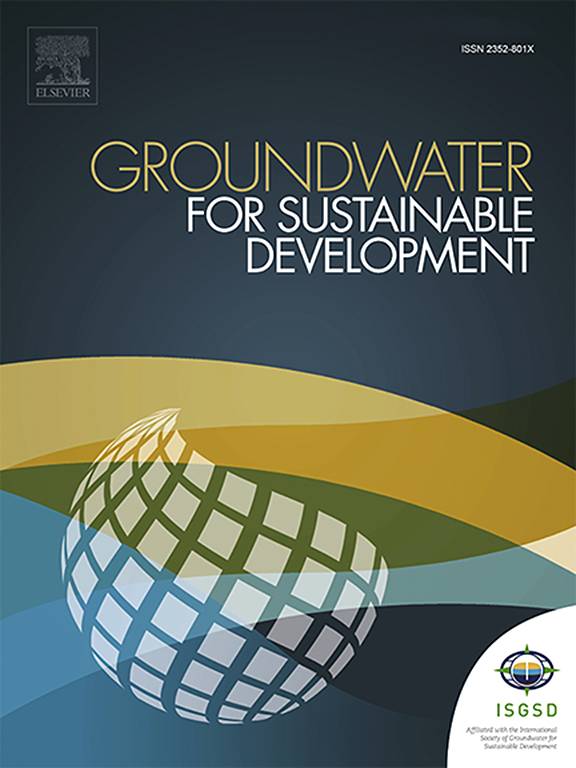通过机器学习在智利中部绘制地下水依赖生态系统的方法
IF 4.9
Q2 ENGINEERING, ENVIRONMENTAL
引用次数: 0
摘要
地下水枯竭会严重影响地下水依赖生态系统的生态完整性。识别和绘制这些生态系统的地图对它们的有效管理和保护至关重要。本研究提出了一种新的概率方法,该方法使用机器学习技术来预测智利中部Ligua和Petorca盆地中gde带的存在。编制了与gde发生相关的21个空间分布解释变量的综合集。这些包括地质、地形、气候和基于卫星的指数。使用包含3067个GDEs存在/不存在点的数据集,随机选择包含原始数据集的100%,75%,50%和25%的子集,训练和评估16种监督分类算法。该分析包括共线性评估、交叉验证、特征选择和超参数调整。基于树的集成模型,包括随机森林(RFC)、AdaBoost (ABC)、梯度增强(GBC)和ExtraTrees (ETC),一直优于其他分类器。在所有子集中,无论样本数量如何,模型在测试分数、F1分数和曲线下面积(AUC)等指标上获得的原始分数都在0.90以上,关键预测变量包括与河流的距离、降雨量和土地利用/土地覆盖。在上述指标上,模型显示出较高的预测性能,始终超过0.95。由此产生的gde地图设法确定了gde存在的高概率区域,并将这些生态系统与邻近的农业区明确区分开来。该研究为gde制图提供了一个强有力的方法框架,并可作为干旱和半干旱环境中管理和保护地下水和gde的宝贵工具。本文章由计算机程序翻译,如有差异,请以英文原文为准。

Approach to mapping groundwater-dependent ecosystems through machine learning in central Chile
Groundwater depletion can significantly impact the ecological integrity of groundwater-dependent ecosystems (GDEs). Identifying and mapping these ecosystems is essential for their effective management and conservation. This study presents a new probabilistic approach that uses machine learning techniques to predict the presence of GDEs zones in the Ligua and Petorca basins, central Chile. A comprehensive set of 21 spatially distributed explanatory variables related to GDEs occurrence was compiled. These include geology, topography, climate, and satellite-based indices. Using a dataset of 3067 GDEs presence/absence points, 16 supervised classification algorithms were trained and evaluated with randomly selected subsets containing 100 %, 75 %, 50 %, and 25 % of the original dataset. This analysis involved collinearity assessment, cross-validation, feature selection, and hyperparameter tuning. Tree-based ensemble models, including Random Forest (RFC), AdaBoost (ABC), Gradient Boosting (GBC), and ExtraTrees (ETC), consistently outperformed other classifiers. In all subsets, regardless of the number of samples included, the models obtained raw scores above 0.90 for metrics such as test score, F1 score and the area under the curve (AUC), with key predictor variables identified as distance to rivers, rainfall, and land use/land cover. The models show high predictive performance consistently exceeding 0.95 on the above metrics. The resulting GDEs map manages to identify areas with a high probability of GDEs presence, clearly differentiating these ecosystems from adjacent agricultural areas. This study provides a robust methodological framework for GDEs mapping and serves as a valuable tool to manage and protect groundwater and GDEs in arid and semi-arid environments.
求助全文
通过发布文献求助,成功后即可免费获取论文全文。
去求助
来源期刊

Groundwater for Sustainable Development
Social Sciences-Geography, Planning and Development
CiteScore
11.50
自引率
10.20%
发文量
152
期刊介绍:
Groundwater for Sustainable Development is directed to different stakeholders and professionals, including government and non-governmental organizations, international funding agencies, universities, public water institutions, public health and other public/private sector professionals, and other relevant institutions. It is aimed at professionals, academics and students in the fields of disciplines such as: groundwater and its connection to surface hydrology and environment, soil sciences, engineering, ecology, microbiology, atmospheric sciences, analytical chemistry, hydro-engineering, water technology, environmental ethics, economics, public health, policy, as well as social sciences, legal disciplines, or any other area connected with water issues. The objectives of this journal are to facilitate: • The improvement of effective and sustainable management of water resources across the globe. • The improvement of human access to groundwater resources in adequate quantity and good quality. • The meeting of the increasing demand for drinking and irrigation water needed for food security to contribute to a social and economically sound human development. • The creation of a global inter- and multidisciplinary platform and forum to improve our understanding of groundwater resources and to advocate their effective and sustainable management and protection against contamination. • Interdisciplinary information exchange and to stimulate scientific research in the fields of groundwater related sciences and social and health sciences required to achieve the United Nations Millennium Development Goals for sustainable development.
 求助内容:
求助内容: 应助结果提醒方式:
应助结果提醒方式:


